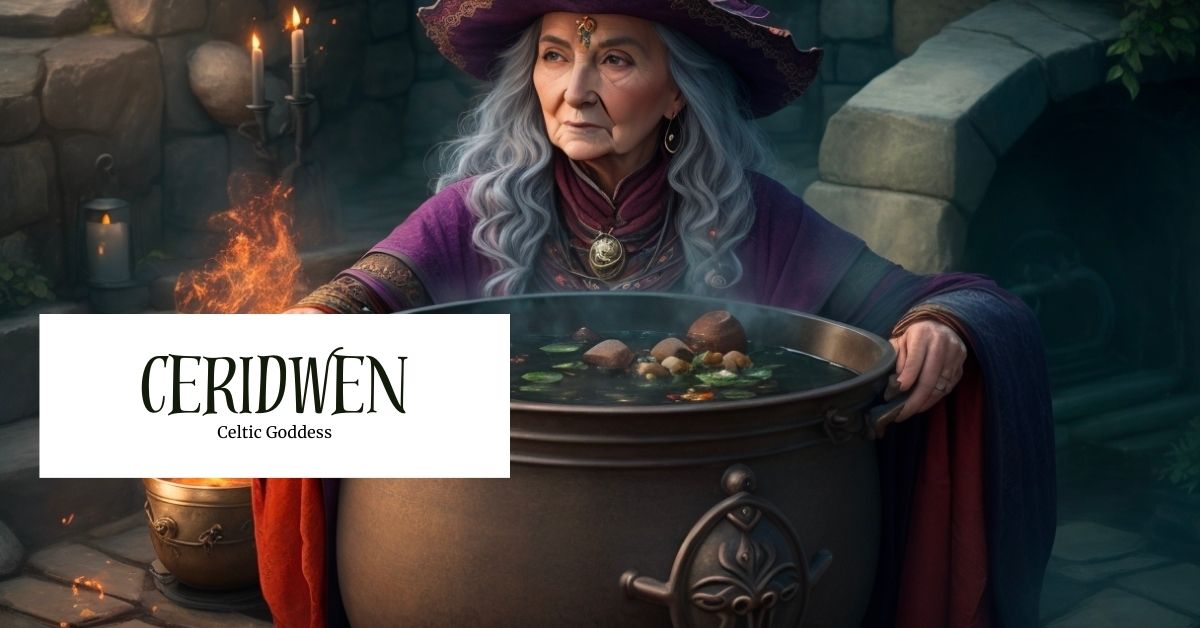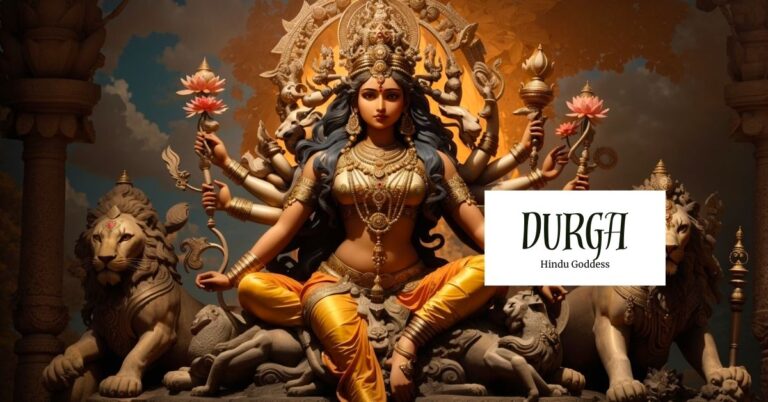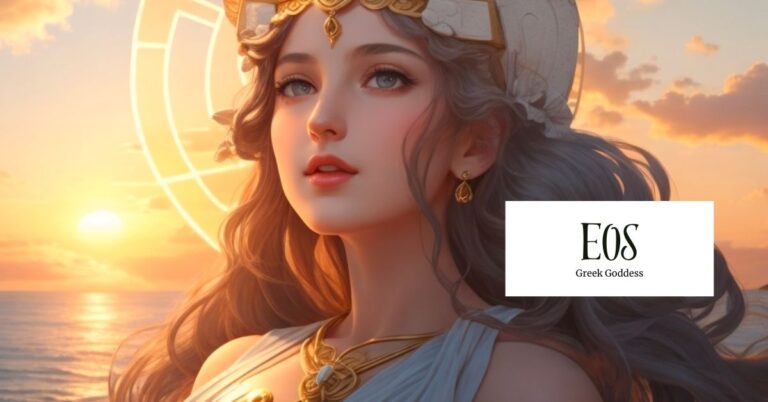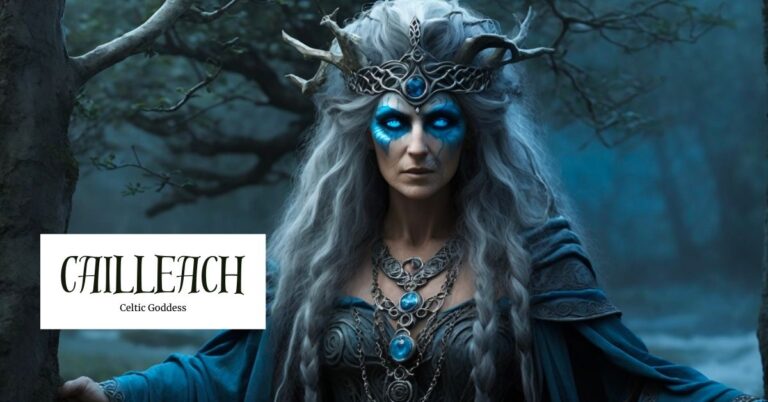Ceridwen: The Goddess of Inspiration
Goddess Ceridwen is a major reason why we have some of the most popular Celtic mythology tales today. She is portrayed as a powerful sorceress, revered for her extraordinary knowledge and magical abilities. While our modern sensibilities may think that her depiction as an old crone may make her weak, she is far from that. She has an immense influence on Celtic mythology that also stretches into inspiring modern day artists with her tales.
Overview of Ceridwen
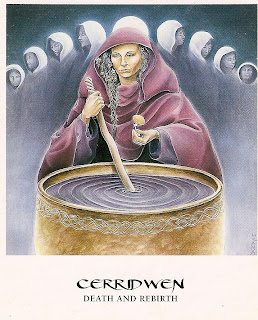
Source: Daily Goddess
Ceridwen, often depicted as a wise woman, is believed to have immense knowledge and supernatural abilities. She weaves her spells and potions in a great cauldron, symbolizing the shape-shifting power of her magic. Her name, sometimes translated as “white witch”, connects her to her origin story and how she is viewed today.
Ceridwen, also referred to as the White Lady, is known as the goddess of wisdom, enchantment, and the cauldron of transformation. Through her ancient tale, reveals the timeless themes of creation, rebirth, and the indomitable power of the human spirit. Her story weaves together the threads of magic, inspiration, and the pursuit of wisdom, inspiring others for their own transformations within themselves.
The goddess of inspiration’s role as a muse and inspiration to poets and bards extends beyond the realms of mysticism. Her connection with the arts helps us understand the depth of her influence and the enduring impact she has on the search for self-discovery and creative potential. An exploration into the tales of Goddess Ceridwen captivates her lessons within her narrative.
Titles
- White Crafty One
- The White Sow
- The Crafty One
- Dark Moon Goddess
- Goddess of Inspiration
- The Grain Goddess
- The Goddess of Death
Abilities
As the goddess of inspiration, she is intimately connected to the forces of nature and channels their energy to award poetic wisdom, creative inspiration, and prophetic insight upon those she chooses. These gifts allow them to tap into their creative potential, guiding them artistically. Ceridwen holds the power of prophecy, offering glimpses into the past, present, and future with clarity. Through her prophetic visions, she shed light on those who seek her guidance to navigate their paths and make informed choices.
Ceridwen is cautious in dispensing her powerful magic potions. Her potions are effective with a single drop. She makes sure to give to those deserving and ready to handle their life-changing nature. Whoever receives these magical potions are prepared to embrace the changes they bring, guarding against misuse or unintended consequences.
She rules over inspiration, fertility, and the magic that permeates the natural world. Her influence extends to the domains of death and regeneration. Her poetic wisdom and prophetic insight flow from her divine essence, resonating with the depths of the human spirit.
Characteristics
Often portrayed as a crone, Goddess Ceridwen possesses a striking appearance that embodies both wisdom and power. Her aged appearance is depicted with wrinkles etched upon her face, showcasing someone who is wise and knowledgeable.
Ceridwen’s attire reflects her connection to nature and magic. She is often depicted wearing flowing robes adorned with symbols of the natural world, such as leaves, flowers, or feathers. Her garments shimmer with mystical energies, hinting at her connection to the unseen forces that shape the world. Whether through her weathered face or her symbolic attire, her appearance captures the essence of her role as a divine figure and a source of inspiration.
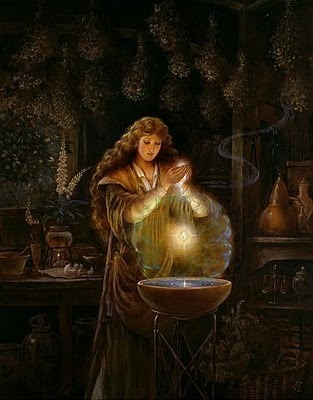
Source: The Touch Bearer, Tumblr
Traits
Goddess Ceridwen’s can be nurturing and unpredictable at times. As a white witch, her natural inclination is to aid and aid others, using her vast knowledge and magical abilities to bring healing, protection, and guidance to those in need. With a compassionate heart, she seeks to uplift and empower those who seek her wisdom and support.
Yet, beneath her sweet exterior lies a streak of fiery determination and a touch of unpredictability. When her crafted plans don’t follow their intended course, Ceridwen’s demeanor can shift, and she may display flashes of anger or frustration. This serves as a reminder of her fierce determination to bring about the desired outcomes and the consequences that may arise when the situation goes wrong.
In her personality, Ceridwen shares similarities with trickster gods. Trickster gods can intuitively be known to have a mischievous and unpredictable nature. Like them, she possesses a streak of cunning and a penchant for pushing boundaries and challenging the status quo. Despite these moments of anger or trickster-like behavior, Ceridwen’s is compassionate and a wanting to bring about positive change.
Symbols
This Celtic Goddess has a variety of symbols with an array of different meanings. At the heart of her symbolism is the Awen, a flowing energy that serves as her muse, given creativity and wisdom into the world. It’s this force of life that fuels her abilities and grants her the power to inspire and transform.
The symbol that holds the most significance to Cerridwen is her cauldron. It’s not only a reason for her extraordinary powers but also a vessel of profound change. The cauldron aids her in fulfilling her duties as the goddess of inspiration. Beyond the cauldron, Ceridwen is associated with a range of symbols that embody her essence. Associated as a moon goddess, Cerridwen represents the dark moon, which represents the phases of the new moon. Her dark moon nature is tied to her abilities to shape-shift and start new beginnings. It reflects her transformative nature and serves as a reminder of the of nature’s yearly cycle of life.
The White Sow symbolizes Ceridwen’s motherly and nurturing nature. It signifies fertility and abundance, highlighting her role as a guardian of growth and sustenance. Hawks, hens, and craws serve as messengers from the spiritual realms, acting as intermediaries between mortal and divine realms. Grain, a symbol of abundance and nourishment, is the life-giving power that Ceridwen embodies.
Lastly, the Crone archetype explains Ceridwen’s wisdom and intuition. It represents the culmination of life’s experiences and the deep reservoirs of knowledge that come with age. As a wise crone figure, Ceridwen holds the keys to ancient wisdom and the mysteries of the universe. From the variety of all these symbols, each of them reflects an aspect of her divine nature and serves as a gateway to understanding her influence in the realms of inspiration, fertility, magic, and wisdom.
Festivals and Rituals
One common ritual involves the setting up of an altar adorned with symbolic elements representing Ceridwen’s essence. At the center of the altar stands a cauldron, a symbol of transformation and the source of her magical powers. It serves as a focal point for ritual offerings and acts as a conduit between the earthly and spiritual realms.
Grain is offered in or alongside the cauldron. These offerings represent the nurturing energies of Ceridwen and serve as a gesture of gratitude for her blessings and guidance. White and green candles, representing purity and growth respectively, are lit to create an ambiance of reverence and sacredness during the ritual.
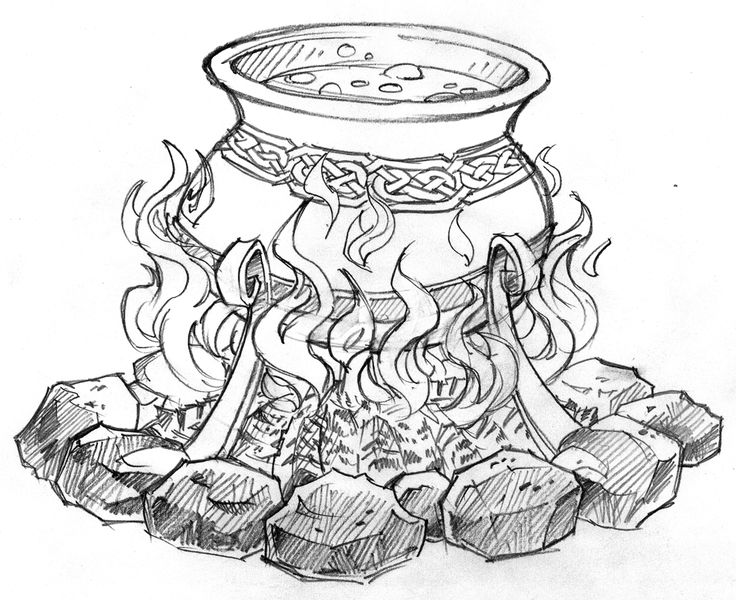
Source: Ulien Tekenen
During these festivals and rituals, participants seek to set up a connection with their ancestors in the spirit world. Ceridwen is called upon as an intermediary between the mortal realm and the realm of the departed. Devotees reach out to their ancestral spirits through prayers, meditation, and divination, seeking their guidance, wisdom, and messages from beyond.
Legends associated with Ceridwen
Ceridwen’s origin story and legends blur together but without this Goddess of inspiration, there would not be other major Celtic figures. It’s important to pay her homage because of her involvement in other great tales.
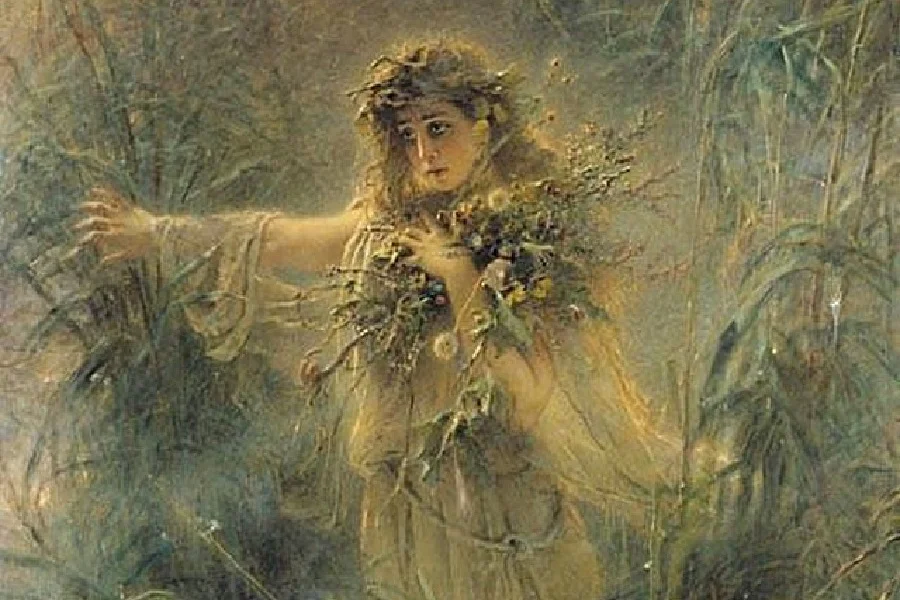
Source: History Cooperative
The story of Goddess Ceridwen is within ancient Welsh folklore and Celtic mythology. According to the tale, Ceridwen and her husband, Tegid Foel, arrived in the land of the Mighty disguised as giants. Their arrival was marked by their possession of a powerful cauldron, a sacred artifact that held great significance.
The lake from which they emerged, known as Llyn Tegid, served as a gateway to The Other World. Upon their arrival, Bran the giant coveted Ceridwen’s cauldron for the safety and protection it could give to her own family. Bran agreed to give the cauldron to Matholuch after a wedding one night. Both of the tribes misused this magnificent cauldron and it caused both of them to fall.
The 15th century was when Ceridwen’s story of poetry and wisdom was circulating the most. The tale was originally told in the Welsh language, which was commonly spoken among Celtic societies, further highlighting its roots in ancient Celtic mythology and traditions.
Tale of Taliesen
It begins with Ceridwen and her husband residing near Bala Lake. They had two children, a son named Morfran and a daughter named Creawry. While Creawry possessed exceptional beauty, Morfran was plagued by an unattractive appearance. In their household, Ceridwen employed a servant boy named Gwion Bach. One fateful day, his carelessness got the better of him, and he touched one of the potions while helping the goddess prepare it for her son. Instantly, Gwion Bach was affected by the magical potion, becoming strikingly beautiful and incredibly intelligent.
Realizing the gravity of his actions, Gwion Bach fled, triggering a thrilling pursuit known as the Rat Race. Ceridwen assumed different animal forms in her relentless pursuit of the servant boy, who constantly changed his shape in a desperate attempt to escape. Ultimately, the epic chase was concluded with Gwion Bach transforming into a grain of corn, and Ceridwen, in the form of a hen, consumed him, thereby proving his cleverness futile.
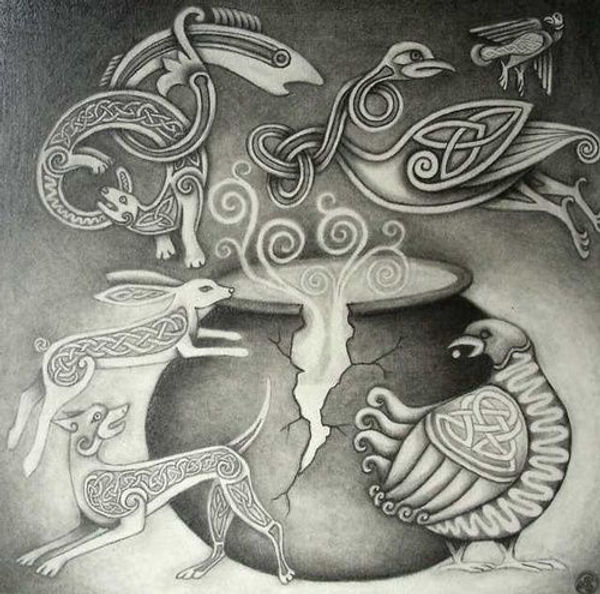
Source: Paul Jameson
However, the story takes an unexpected turn when Ceridwen, after consuming Gwion Bach, becomes pregnant with his reincarnation. Despite her first intentions to kill the child upon his birth, she discovers that he’s exceptionally beautiful. Not wanting to kill or keep him, Ceridwen placed him in a leather bag and floated him out to sea.
Fate intervenes when the bag is discovered and opened by Prince Elffin ap Gwyddno. Within it, he finds the baby boy, whom he names Taliesen. As Taliesen grows, he develops an extraordinary talent for poetry and becomes a celebrated figure in Celtic mythology. His enchanting verses and wondrous compositions gave a profound influence on the world around him, leaving an indelible mark on the realm of poetry and storytelling.
Morfran’s Involvement with King Arthur
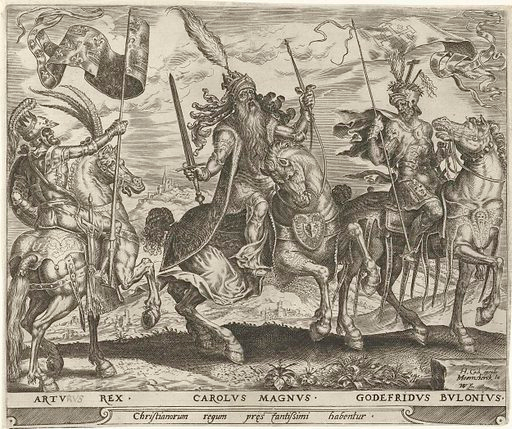
Source: Look and Learn
As the story goes, her son Morfran, bearing the wisdom and magic inherited from his mother, journeys to the court of King Arthur, where destiny beckons. In the midst of King Arthur’s reign, a quest is in search of the Holy Grail, a sacred vessel said to have immense power and the ability to give blessings upon those who find it.
Little did the knights of the Round Table realize that the origins of this revered artifact were entwined with the mystical legacy of Ceridwen. It’s said that the inspiration of the Holy Grail may have emerged from Ceridwen’s cauldron, a major symbol of divine knowledge. This cauldron, infused with the enchantments of the goddess, held the secrets of the universe and the potential to grant extraordinary gifts.
Influences of other religions/cultures on Ceridwen
Goddess Ceridwen’s reputation had changed to align her story with the beliefs of Catholic Christians during a particular period. To make her narrative more agreeable to the prevailing Christian worldview, certain aspects of her mythology were simplified or left out.
During this time, Ceridwen was portrayed as a white witch, emphasizing her role as a helpful figure who assisted people in need. The focus shifted away from her magical cauldron and the rich legends associated with it. Instead, her identity as a magical being was downplayed, and she was depicted as a loving character known for her aid and support.
Modern appearances
Goddess Ceridwen continues to make modern appearances, being in many forms of media. In Octavia Randolph’s The Circle of Ceridwen series, a character named Ceridwen takes center stage in a historical setting. While drawing inspiration from the goddess’s name, the series incorporates elements of Norse and Germanic mythology. This infuses her story with new dimensions and cultural influences. I highly recommend this series!
In the film adaptation of T.H. White’s “The Sword in the Stone,” Ceridwen’s pursuit of Gwion showcased through the characters of Merlin and Madam Mim. Though portrayed as a stereotypical witch and hag, the chase takes a different course, providing a unique twist to the ancient tale. Her timeless presence continues to inspire creative adaptations in media.
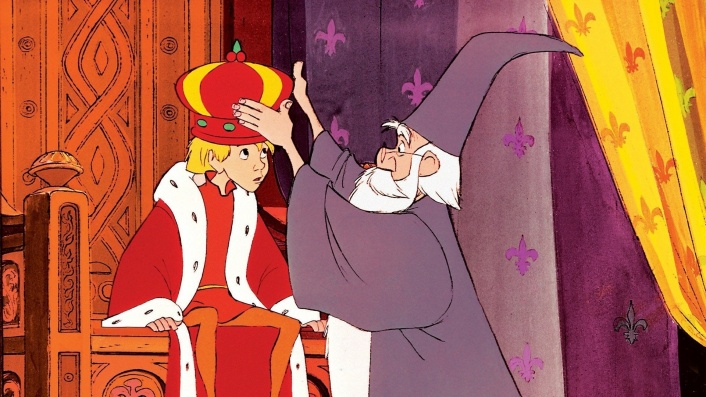
Source: Flicks
Cerridwen’s Cauldron appears in Sarah J. Maas’ A Court of Thorns as Roses as the creator of the world from whence all came. There’s also a minor character named Cerridwen, though it appears (so far) the connection is only using her as a namesake.
Final thoughts
As the Celtic goddess’ inspiration, her presence moves through both legends and modern interpretations. Ceridwen’s portrayal as a crone and white witch adds depth to her character, showcasing both her wisdom and her ability to aid those in need. Her cauldron, a symbol of life, transformation, and potent magic, holds a central place in her mythology, bestowing poetic wisdom, inspiration, and prophecy known as Awen.
Goddess Ceridwen lies not only in her magical abilities and divine wisdom. She is also connected to the realms of inspiration, fertility, magic, death, regeneration, and knowledge. Her presence transcends time, inviting us to explore the mysteries of the natural world and delve into the depths of our own creative potential.
Her symbolism, from the cauldron to the dark moon, the white sow to the hawks and hens, carries profound meaning, representing abundance, wisdom, spiritual guidance, and the cyclical nature of life itself. Through her tales, we are reminded of the timeless truths and eternal wisdom within the embrace of her divine feminine.

